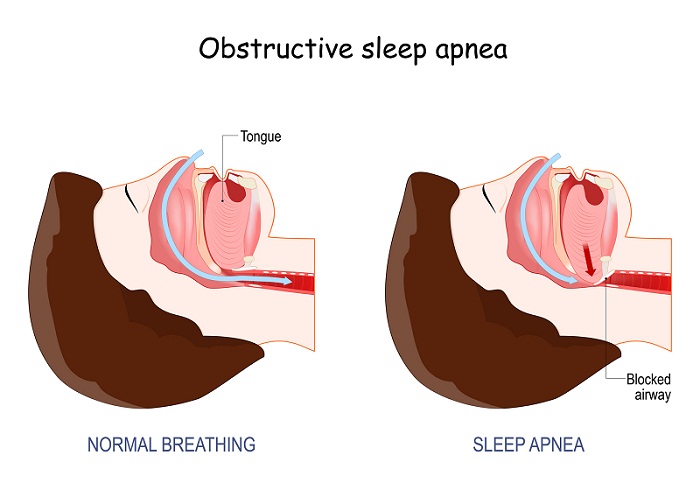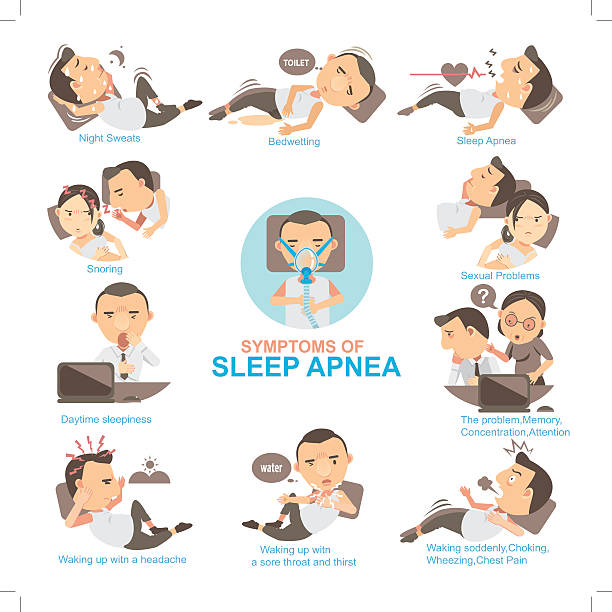Obstructive sleep apnea (OSA) is a potentially serious sleep disorder. During sleep breathing stops repeated which leads to decline in blood oxygen level. There are several types of sleep apnea, but the most common is obstructive sleep apnea. This type of apnea occurs when your throat muscles intermittently relax and block your airway during sleep. A noticeable sign of obstructive sleep apnea is snoring.
What Is Obstructive Sleep Apnea?

Who Is at Risk for Obstructive Sleep Apnea?
Risk for OSA increases if you have conditions or features that narrow the upper airway. Risk factors of OSA include:
- Obese persons
- children with large tonsils and adenoids
- men with thick neck, a collar size of 17 inches or more
- women with thick neck, a collar size of 16 inches or more
- large tongue, which can block the airway
- retrognathia, which is when your lower jaw is shorter than your upper jaw
- a narrow palate or airway that collapses more easily
What are symptoms of Sleep Apnea?
Risk for OSA increases if you have conditions or features that narrow the upper airway. Risk factors of OSA include:
- Excessive daytime sleepiness
- Loud snoring
- Observed episodes of stopped breathing during sleep
- Abrupt awakenings accompanied by gasping or choking
- Awakening with a dry mouth or sore throat
- Morning headache
- Difficulty concentrating during the day
- Experiencing mood changes, such as depression or irritability
- High blood pressure
- Nighttime sweating
- Decreased libido



How Is Obstructive Sleep Apnea Diagnosed?
A diagnosis of sleep apnea begins with a complete history and physical examination. A history of daytime drowsiness and snoring are important clues. Your doctor will examine your head and neck to identify any physical factors that are associated with sleep apnea. Your doctor may ask you to fill out a questionnaire about daytime drowsiness, sleep habits, and quality of sleep. Tests that may be performed include:
Polysomnogram
A polysomnogram usually requires that you stay overnight in a hospital or a sleep study center. The test lasts for an entire night. While you sleep, the polysomnogram will measure the activity of different organ systems associated with sleep. It may include:
- electroencephalogram (EEG), which measures brain waves
- electro-oculogram (EOM), which measures eye movement
- electromyogram (EMG), which measures muscle activity
- electrocardiogram (EKG or ECG), which measures heart rate and rhythm
- pulse oximetry test, which measures changes in your oxygen levels in your blood
- arterial blood gas analysis (ABG)
What are treatments for Obstructive Sleep Apnea Diagnosed?
The goal for treatment of sleep apnea is to make sure airflow isn’t obstructed during sleep. Treatment methods include:
Weight Loss
Weight loss gives excellent relief from the symptoms of OSA.
Nasal Decongestants
Nasal decongestants are more likely to be effective in mild OSA. They can help relieve snoring.
Continuous Positive Airway Pressure (CPAP)
Continuous positive airway pressure (CPAP) therapy is the first line of treatment for obstructive sleep apnea. CPAP is administered through a facemask that’s worn at night. The facemask gently delivers positive airflow to keep the airways open at night. The positive airflow props the airways open. CPAP is a highly effective treatment for sleep apnea. A dental device may also be necessary to keep the lower jaw positioned forward.
Positional Therapy
Since sleeping on the back (supine position) can make sleep apnea worse for some people, positional therapy is used to help those with sleep apnea learn to sleep in other positions. Positional therapy and the use of CPAP can be discussed with a professional at a sleep center.
Surgery
Uvulopalatopharyngoplasty (UPPP) involves removal of extra tissues from the back of the throat. UPPP is the most common type of surgery for OSA, and it helps relieve snoring. However, this surgery hasn’t been proven to totally eliminate sleep apnea, and it can have complications.
